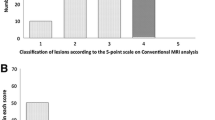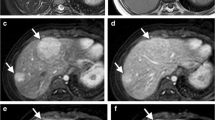Abstract
Objective
Hepatocyte-specific contrast agents are used to help characterize liver lesions. However, there are no studies evaluating the utility of these agents in detecting or diagnosing pediatric liver lesions. The purpose of this study is to assess the impact of the hepatocyte phase of imaging on lesion detection, tumor staging and diagnostic confidence.
Materials and methods
All patients undergoing an MRI between September 2010 and August 2012 using gadoxetate disodium as the contrast agent were included in this study. Each exam was duplicated so that one copy contained all sequences, including the hepatocyte phase of imaging, and the other copy contained all sequences except the hepatocyte phase of imaging. One reviewer evaluated all exams in a blinded, random fashion. Data tracked included imaging diagnosis, confidence in diagnosis, number of lesions and PRETEXT grade. The imaging diagnosis was compared to histopathology, when available. Data were analyzed for the study population as well as the subset of patients diagnosed with focal nodular hyperplasia (FNH).
Results
There were 112 patients (56 male; mean age: 9.25 years) included in this study. A total of 33 patients had a malignant tumor and the remainder had either a benign lesion or no lesion. The addition of the hepatocyte phase of imaging significantly improved the diagnostic confidence for all patients (P < 0.0001) as well as specifically for patients diagnosed with FNH (P = 0.003). In nearly a quarter of patients, the hepatocyte phase of imaging allowed the reviewer to detect additional lesions (P = 0.005). In the patients with a malignant tumor, the addition of the hepatocyte phase of imaging changed the PRETEXT grade in 7/30 patients although the results were not significant (P = 0.161).
Conclusion
The addition of the hepatocyte phase of imaging helps to improve lesion detection and increase the diagnostic confidence for all liver tumors, as well as for FNH in particular.







Similar content being viewed by others
References
Adeyiga AO, Lee EY, Eisenberg RL (2012) Focal hepatic masses in pediatric patients. AJR Am J Roentgenol 199:W422–W440
Chung EM, Cube R, Lewis RB et al (2010) From the archives of the AFIP: pediatric liver masses: radiologic-pathologic correlation part 1. Benign tumors. Radiographics 30:801–826
Chung EM, Lattin GE Jr, Cube R et al (2011) From the archives of the AFIP: pediatric liver masses: radiologic-pathologic correlation. Part 2. Malignant tumors. Radiographics 31:483–507
Das CJ, Dhingra S, Gupta AK et al (2009) Imaging of paediatric liver tumours with pathological correlation. Clin Radiol 64:1015–1025
Meyers AB, Towbin AJ, Serai S et al (2011) Characterization of pediatric liver lesions with gadoxetate disodium. Pediatr Radiol 41:1183–1197
Benz-Bohm G, Hero B, Gossmann A et al (2010) Focal nodular hyperplasia of the liver in longterm survivors of neuroblastoma: how much diagnostic imaging is necessary? Eur J Radiol 74:e1–e5
Joyner BL Jr, Levin TL, Goyal RK et al (2005) Focal nodular hyperplasia of the liver: a sequela of tumor therapy. Pediatr Radiol 35:1234–1239
Smith EA, Salisbury S, Martin R et al (2012) Incidence and etiology of new liver lesions in pediatric patients previously treated for malignancy. AJR Am J Roentgenol 199:186–191
Frydrychowicz A, Lubner MG, Brown JJ et al (2012) Hepatobiliary MR imaging with gadolinium-based contrast agents. J Magn Reson Imaging 35:492–511
Seale MK, Catalano OA, Saini S et al (2009) Hepatobiliary-specific MR contrast agents: role in imaging the liver and biliary tree. Radiographics 29:1725–1748
Goshima S, Kanematsu M, Watanabe H et al (2010) Hepatic hemangioma and metastasis: differentiation with gadoxetate disodium-enhanced 3-T MRI. AJR Am J Roentgenol 195:941–946
Grieser C, Steffen IG, Seehofer D et al (2013) Histopathologically confirmed focal nodular hyperplasia of the liver: gadoxetic acid-enhanced MRI characteristics. Magn Reson Imaging 31:755–760
Bieze M, van den Esschert JW, Nio CY et al (2012) Diagnostic accuracy of MRI in differentiating hepatocellular adenoma from focal nodular hyperplasia: prospective study of the additional value of gadoxetate disodium. AJR Am J Roentgenol 199:26–34
Grazioli L, Bondioni MP, Haradome H et al (2012) Hepatocellular adenoma and focal nodular hyperplasia: value of gadoxetic acid-enhanced MR imaging in differential diagnosis. Radiology 262:520–529
Jeong HT, Kim MJ, Park MS et al (2012) Detection of liver metastases using gadoxetic-enhanced dynamic and 10- and 20-minute delayed phase MR imaging. J Magn Reson Imaging 35:635–643
Choi JY, Choi JS, Kim MJ et al (2010) Detection of hepatic hypovascular metastases: 3D gradient echo MRI using a hepatobiliary contrast agent. J Magn Reson Imaging 31:571–578
Shimada K, Isoda H, Hirokawa Y et al (2010) Comparison of gadolinium-EOB-DTPA-enhanced and diffusion-weighted liver MRI for detection of small hepatic metastases. Eur J Radiol 20:2690–2698
Meyers AB, Towbin AJ, Geller JI et al (2012) Hepatoblastoma imaging with gadoxetate disodium-enhanced MRI–typical, atypical, pre- and post-treatment evaluation. Pediatr Radiol 42:859–866
Tamrazi A, Vasanawala SS (2011) Functional hepatobiliary MR imaging in children. Pediatr Radiol 41:1250–1258
Roebuck DJ, Aronson D, Clapuyt P et al (2007) 2005 PRETEXT: a revised staging system for primary malignant liver tumours of childhood developed by the SIOPEL group. Pediatr Radiol 37:123–132
Ringe KI, Husarik DB, Sirlin CB et al (2010) Gadoxetate disodium-enhanced MRI of the liver: part 1, protocol optimization and lesion appearance in the noncirrhotic liver. AJR Am J Roentgenol 195:13–28
Cruite I, Schroeder M, Merkle EM et al (2010) Gadoxetate disodium-enhanced MRI of the liver: part 2, protocol optimization and lesion appearance in the cirrhotic liver. AJR Am J Roentgenol 195:29–41
Gupta A, Sheridan RM, Towbin A et al (2013) Multifocal hepatic neoplasia in 3 children with APC gene mutation. Am J Surg Pathol 37:1058–1066
Towbin AJ, Luo GG, Yin H et al (2011) Focal nodular hyperplasia in children, adolescents, and young adults. Pediatr Radiol 41:341–349
Conflicts of interest
None
Author information
Authors and Affiliations
Corresponding author
Rights and permissions
About this article
Cite this article
Kolbe, A.B., Podberesky, D.J., Zhang, B. et al. The impact of hepatocyte phase imaging from infancy to young adulthood in patients with a known or suspected liver lesion. Pediatr Radiol 45, 354–365 (2015). https://doi.org/10.1007/s00247-014-3160-4
Received:
Revised:
Accepted:
Published:
Issue Date:
DOI: https://doi.org/10.1007/s00247-014-3160-4




